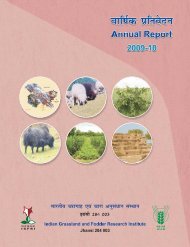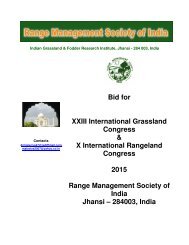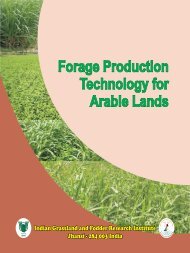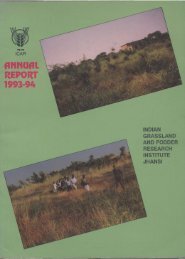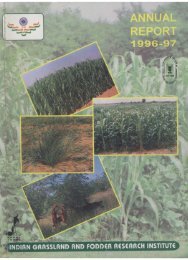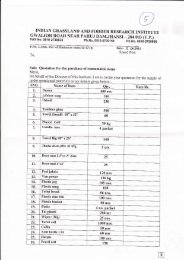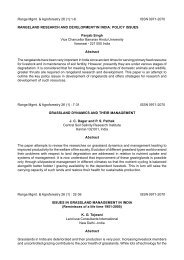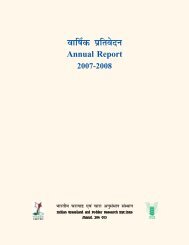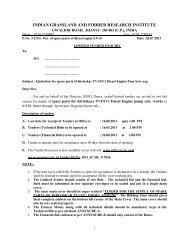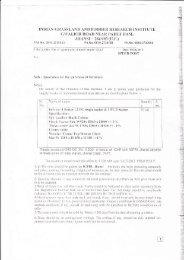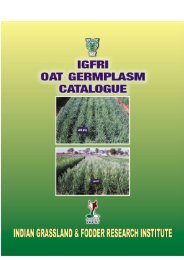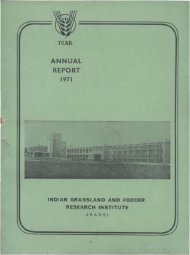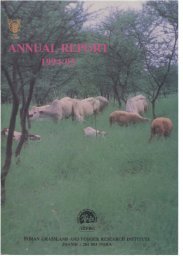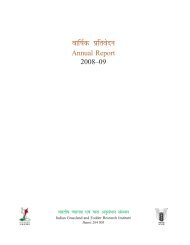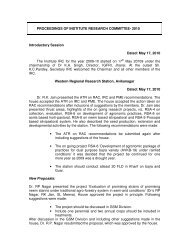IGFRI Vision 2050 - Indian Grassland and Fodder Research Institute ...
IGFRI Vision 2050 - Indian Grassland and Fodder Research Institute ...
IGFRI Vision 2050 - Indian Grassland and Fodder Research Institute ...
You also want an ePaper? Increase the reach of your titles
YUMPU automatically turns print PDFs into web optimized ePapers that Google loves.
<strong>Vision</strong> <strong>2050</strong><br />
5. Goal <strong>and</strong> Targets<br />
5.1 Goal<br />
To generate <strong>and</strong> disseminate technologies for enhanced productivity <strong>and</strong><br />
quality of forage <strong>and</strong> livestock in socio-economic <strong>and</strong> environmental<br />
perspectives<br />
Developing <strong>IGFRI</strong> as a global knowledge centre in the field of forage<br />
resource development<br />
5.2 Targets <strong>and</strong> component activities<br />
5.2.1 Genetic enhancement <strong>and</strong> forage cultivar/variety development<br />
Acquisition, conservation <strong>and</strong> effective utilization of fodder biodiversity will<br />
continue to be the focus in coming decades. With the advancement in<br />
technologies, utilization of biodiversity for fodder crop improvement would be<br />
more effective <strong>and</strong> precise. More synergistic network of PGR, breeding,<br />
biotechnology, biochemistry <strong>and</strong> physiology <strong>and</strong> plant pathology is envisaged<br />
in forthcoming years. Plant breeding activities will be strengthened by<br />
enrichment <strong>and</strong> management of forage plant genetic resources, pyramiding<br />
genes for multiple stress tolerance (biotic <strong>and</strong> abiotic) <strong>and</strong> desirable fodder<br />
traits, development of new plant types based on climate change parameters,<br />
utilizing pre-breeding efforts, development <strong>and</strong> utilization of wide–adaptive<br />
male sterility systems in grain fodders, identification of genes for generating<br />
perennial grain fodder, fortification of fodder/dual purpose crops for<br />
enhanced nutrition <strong>and</strong> resistance, identification, cloning <strong>and</strong> characterization<br />
of key regulatory genes for fodder traits like plant architecture, flowering time,<br />
foliage, adaptability <strong>and</strong> quality, biochemical/metabolic engineering to<br />
modulate quality components in fodders, <strong>and</strong> enhancing fodder traits in<br />
otherwise grain crops, modulation, the mode of reproduction utilizing genes for<br />
apomictic form of reproduction, generate repository of complete<br />
transcriptome for life cycle, quality <strong>and</strong> stress characteristics from appropriate<br />
accessions, studying disease etiology <strong>and</strong> pest genomics <strong>and</strong> occurrence of new<br />
pests <strong>and</strong> diseases under changing climate <strong>and</strong> estimation of losses etc.<br />
5.2.2. Management of resources to enhance forage productivity<br />
The major concern of fodder production is to reduce the cost of production with<br />
international quality st<strong>and</strong>ards, <strong>and</strong> in eco-friendly environment. The<br />
research for the development of forage based cropping system/silvi-hortipastoral<br />
system for extreme weather situations; mitigation <strong>and</strong> adaptation<br />
strategies, st<strong>and</strong>ardization <strong>and</strong> validation of district-wise forage production<br />
15



